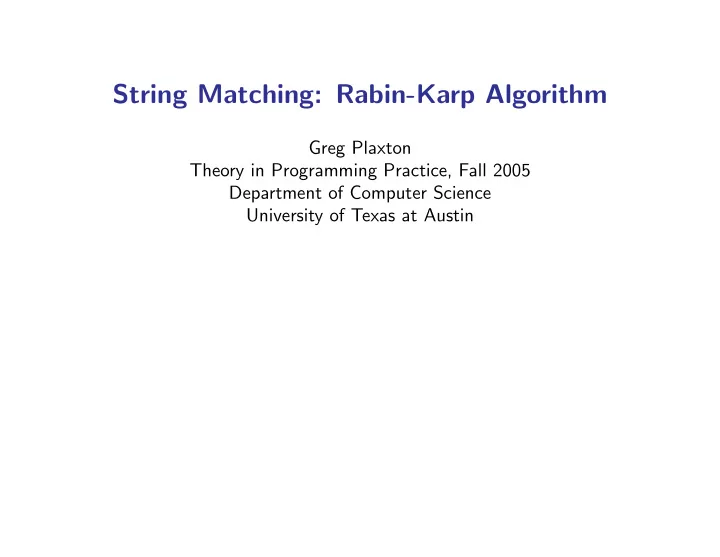

String Matching: Rabin-Karp Algorithm Greg Plaxton Theory in Programming Practice, Fall 2005 Department of Computer Science University of Texas at Austin
The (Exact) String Matching Problem • The (exact) string matching problem: Given a text string t and a pattern string p , find all occurrences of p in t • A naive algorithm for this problem simply considers all possible starting positions i of a matching string within t , and compares p to the substring of t beginning at each such position i – The worst-case complexity of this algorithm is Θ( mn ) , where m denotes the length of p and n denotes the length of t – Can we do better? Theory in Programming Practice, Plaxton, Fall 2005
Three Efficient String Matching Algorithms • Rabin-Karp (today) – This is a simple randomized algorithm that tends to run in linear time in most scenarios of practical interest – The worst case running time is as bad as that of the naive algorithm, i.e., Θ( mn ) • Knuth-Morris-Pratt – The worst case running time of this algorithm is linear, i.e., O ( m + n ) • Boyer-Moore – This algorithm tends to have the best performance in practice, as it often runs in sublinear time – The worst case running time is as bad as that of the naive algorithm Theory in Programming Practice, Plaxton, Fall 2005
The Rabin-Karp String Matching Algorithm • Assume the text string t is of length m and the pattern string p is of length n • Let s i denote the length- n contiguous substring of t beginning at offset i ≥ 0 – So, for example, s 0 is the length- n prefix of t • The main idea is to use a hash function h to map each s i to a good- sized set such as the set of the first k nonnegative integers, for some suitable k – Initially, we compute h ( p ) – Whenever we encounter an i for which h ( s i ) = h ( p ) , we check for a match as in the naive algorithm – If h ( s i ) � = h ( p ) , we don’t need to check for a match Theory in Programming Practice, Plaxton, Fall 2005
The Choice of Hash Function • It should be easy to compare two hash values – For example, if the range of the hash function is a set of sufficiently small nonnegative integers, then two hash values can be compared with a single machine instruction • The number of false positives induced by the hash function should be similar to that achieved by a “random” function – If the range of the hash function is of size k , we’d like each hash value to be achieved by approximately the same number of n -symbol strings (where n is the length of the pattern) • It should be easy (e.g., a constant number of machine instructions) to compute h ( s i +1 ) given h ( s i ) Theory in Programming Practice, Plaxton, Fall 2005
A Possible Choice for the Hash Function • Suppose we hash each string to the XOR of the ASCII values of its characters – Is this a good choice of hash function with respect to the criteria mentioned on the previous slide? • What if we hash each string to the sum of the ASCII values of its characters? • What if we view each string as a nonnegative number? – For example, an ASCII string may be viewed as a base 256 number – Alternatively, an n -symbol ASCII string may be viewed as an (8 n ) -bit number Theory in Programming Practice, Plaxton, Fall 2005
A Good Choice for the Hash Function • View each string as a nonnegative number, but take the result modulo k for some suitable modulus k • For example, we might take k to be 2 32 , to ensure that the hash values can be stored in a 32 -bit integer • In practice the modulus k is generally taken to be a prime (e.g., a 32 -bit prime) in order to better destroy any structure in the input data – For example, note that the 8-bit ASCII codes for printable characters all begin with a 0 – So if we use k = 2 32 , bits 7, 15, 23, and 31 of the hash of a printable string are guaranteed to be zero • But can we still compute h ( s i +1 ) from h ( s i ) efficiently? Theory in Programming Practice, Plaxton, Fall 2005
Recommend
More recommend